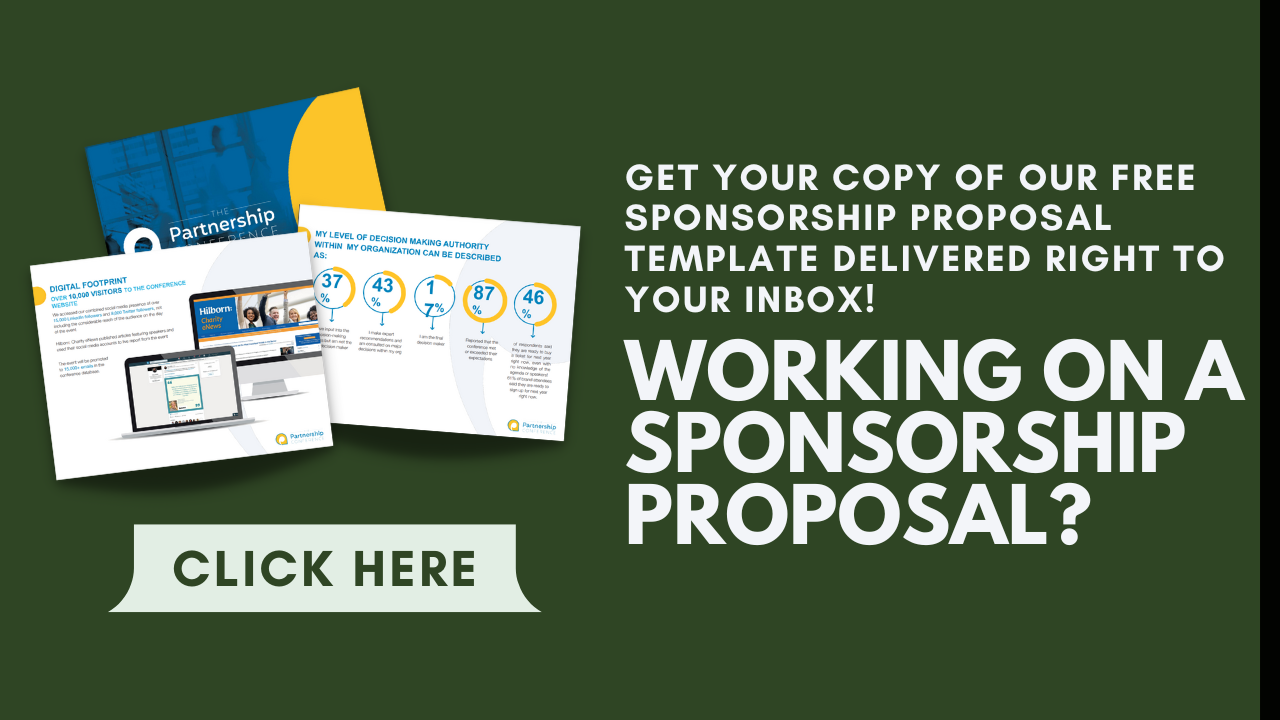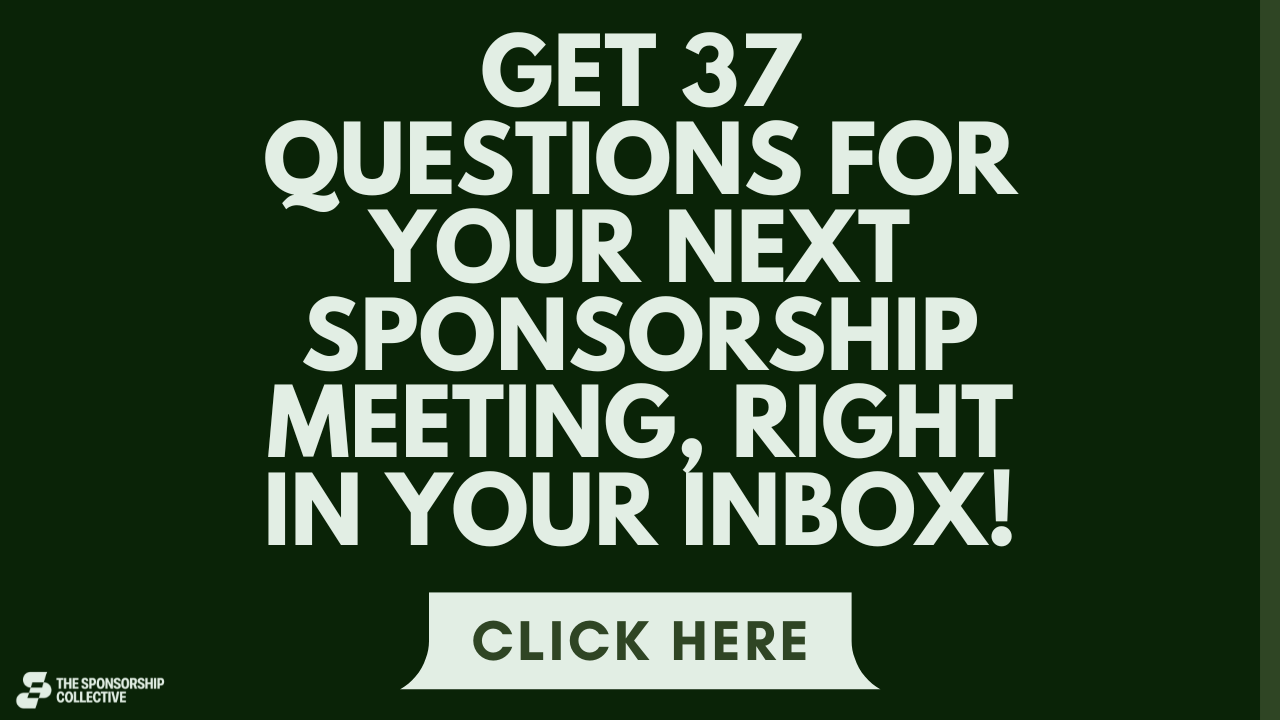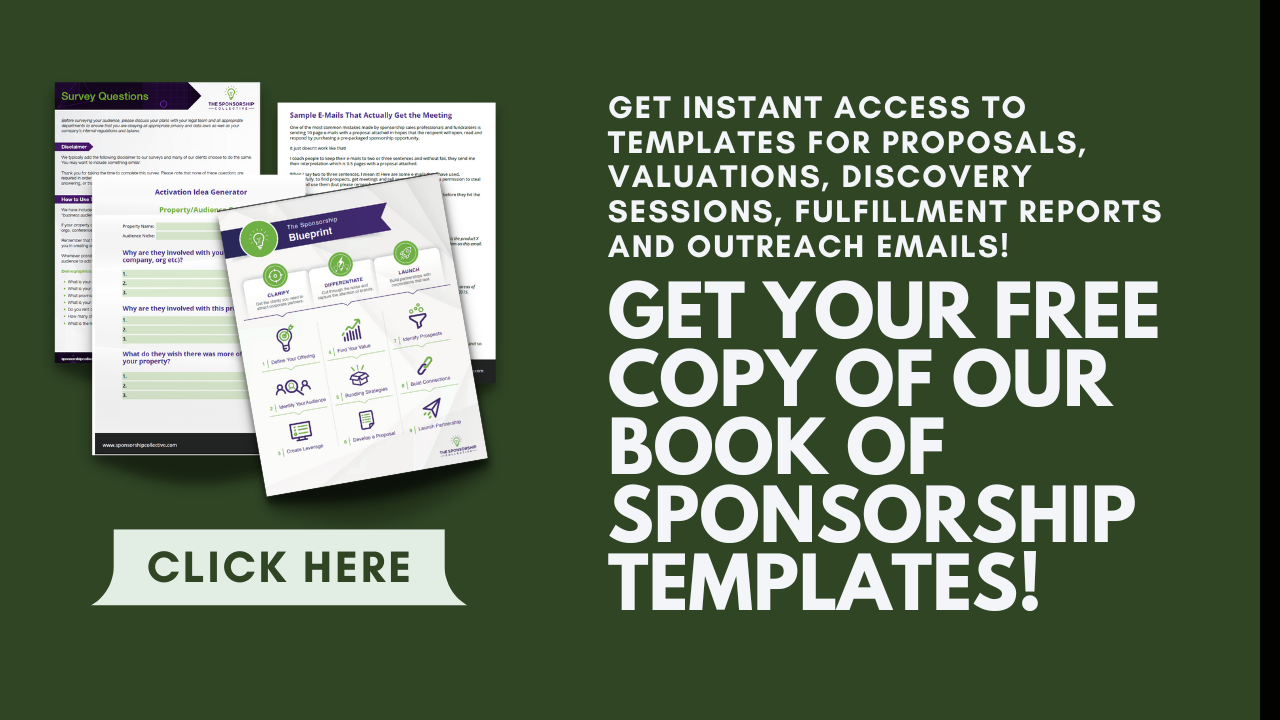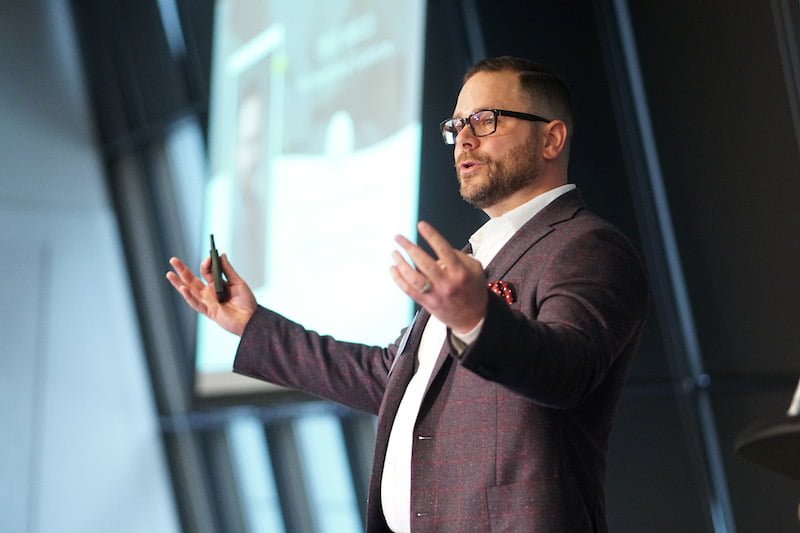As a nonprofit, major event, small business or sports team, you lack the capital and reach needed to make your event or fundraiser a reality. Having a corporate sponsorship would really help put you on the map, but you always feel like the little fish in the big pond. How can you successfully approach corporations and get them to agree to your sponsorship request?
To obtain a corporate sponsorship, make sure you do the following:
- Choose companies with values more aligned to yours
- Give something back to them
- Have a strong, clear, engaging proposal
- Don’t wait until right before your event to ask for a sponsorship
- If you know how much money you need, ask for it outright
- Reach out again if you don’t hear back
In this article, we’ll elaborate more on all the points introduced above, walking you through what you need to know. By the time you’re done reading, you’ll feel ready to muster up the courage and chase your own corporate sponsorship.
The Benefits of a Corporate Sponsorship
Some smaller companies may convince themselves they can go without a corporate sponsorship, especially if they’ve been turned down by bigger brands time and time again. While it’s not always easy to gain one of these sponsorships, having one can pay dividends for your business. Here are some benefits you’d enjoy.
Credibility
Every small business or individual businessperson wants to stand out, but the competition out there is fierce. With the backup of a bigger corporation through a sponsorship, your own company gains credibility. This can attract more interest and revenue for your business.
Brand Recognition
One doesn’t become a household name like Google, Apple, or Nike overnight. Having a successful event or fundraiser with the support of a corporate sponsorship is certainly one way to get your foot in the door, though. Now everyone will begin talking about your company and its recent achievements.
Expanded Reach
As these new curious faces gravitate towards your business, your audience has the potential to grow. It’s now your job to tend to this influx of leads, building a relationship with them and converting them to loyal, buying customers, fans or donors.
Connection
The partnership between you and the bigger corporation could be a one-time deal, although you hope it will become a longer-term arrangement. This sense of connection brings with it networking opportunities and a further chance to increase the size of your customer base.
Asking for Sponsorship – Four Questions to Consider Before You Make the Ask
We all want sponsorship today, right now, yesterday. I get it, but if all your attempts have garnered radio silence to this point, it’s time to change your approach, because what you’re doing isn’t working.
Here are four important questions you need answers to before you can proceed.
Do I Have Audience Data? How Much?
Sponsors don’t want generic everyman data on your audience. On that note, neither do investors, vendors, and other partners.
You’re also probably not succeeding at your marketing objectives without uncovering the nuances of your audience. It’s worth knowing as much about the people who keep your business running as possible.
I recommend at least 25 data points for each audience segment.
For example, if you have an audience group of 20-somethings from New York City who make $68,000 per year, you can dig a lot deeper into that segment. How many 21-year-olds versus 23-year-olds comprise this group?
What industry do they belong in? What are their job titles? Do they own a home or rent?
Once you begin asking yourself these kinds of questions about each audience group, you’ll easily pull the required amount of data.
Do I Know What My Opportunity Is Worth?
There is only one way to be 100 percent, unequivocally sure of what your sponsorship opportunity is valued at, and that’s through valuation.
If you haven’t valued your assets and activations yet, please do so before you ask for sponsorship. A sponsor is going to want to know what your opportunity is worth, especially as you get deeper into meetings, and they’re going to want to know how you did your math.
That means no guessing your value. You also can’t get away with copying or pulling a number from thin air.
Have I Created Custom Activations and Assets Tailored to the Sponsor’s Needs?
You can have a list of assets and activations on standby, but you must finesse each to suit your specific sponsor’s needs. If you issue generic sponsorship assets like logos and shoutouts from the podium, your request for sponsorship could be turned down.
Am I Asking Too Early?
This might be the most important question you ask yourself.
You should never ask for sponsorship right out of the gate. That’s a surefire way to get a refusal, usually in the form of being ghosted or outright ignored.
You also shouldn’t ask during the discovery session or immediately afterward. Instead, the right time to ask is when you’ve presented your assets and activations and the sponsor seems interested and you’re ready to move forward.
How to Ask for Sponsorship and Get It – The Steps You Need to Know
So, what’s required to successfully ask for sponsorship? I’ve broken it down into a handy, six-step process to send you on your way.
Know What You Need
Sponsorship is not simply a situation of “ask and ye shall receive.” It’s a give-and-take, a financial exchange where you provide outcomes and receive money.
A sponsor wants to help you like you’re eager to assist them. However, they can only do that if you provide them with basic information.
I always tell my clients to be upfront with the financial amount you’re looking for if you’re chasing a cash sponsor. It’s the same with any other kind of sponsor, from contra to media partnerships.
If you need $10,000 or 5,000 branded T-shirts, tell your sponsor. They can’t guess at what’s going on in your head, and besides, they’re too busy to do that, anyway.
Knowing that you need in the beginning stages of sponsorship is static. You will make adjustments as you continue planning your event, program, or opportunity, and that’s okay. Sponsors expect it.
However, a small fluctuation is one thing, and suddenly asking for $50,000 when a month ago it was $10,000 is another.
Determine What You Can Provide
Okay, so you know what you’re going to ask the sponsor for, now, what are you going to give to them? What does a company want in exchange for offering you sponsorship?
It boils down to three tiny letters that mean so much. ROI.
Yep, it’s simple! If a sponsor gives you $10,000, they want to ensure they make $20,000 or $30,000 from the transaction.
That means your assets and activations need to achieve goals, such as more email newsletter signups or customer conversions. And that’s why generic assets you offer to every sponsor won’t work here.
Generate a List of Prospects
Next, it’s time to build your prospects list.
While technically, any potential partner can be a prospect, not all prospects are created equally. If you Google Fortune 500 companies and take every company with a name that appears on the first page, you’re not going to get very far.
That’s not the proper way to prospect. Plus, these major companies are so inundated with sponsorship requests that yours will surely get overlooked (no offense!).
The right way to prospect for sponsors is through your audience. They will share their insights and brand preferences when you survey them to build more detailed audience data, and those preferences are the backbone of your prospects list.
Since these prospects came directly from the horse’s mouth, so to speak, there’s a deeper audience connection than with that Fortune 500 company you found on the first page of Google. That audience connection is everything.
If you have a huge sponsor but your audience doesn’t care for their products or services, you will fail to help the sponsor. You two will not work together again.
However, I always tell my clients to research their prospects before making contact. Your audience is full of free-thinking individuals. The brands they choose do not necessarily reflect your company values.
That’s up to you to determine by researching each prospect independently. This basic research is also an opportunity to learn more about what the sponsor does, what kinds of services they might be interested in, and if they’re available for sponsorship.
If you can’t find all that information online, don’t sweat it. There will be time for those answers coming up, such as when you…
Have a Discovery Session
The discovery session is your opportunity to delve deep into the facets of the sponsor company that you need more intel on and those you could never find through online research. I’m talking about the real nitty-gritty data, such as their social engagement, email open rates, website traffic, and sales.
The purpose of the discovery session is to learn about which areas your prospective sponsor is falling flat so you can devise ways to prop them up with your assets and activations. It’s not a sales meeting. It’s also not an opportunity to ask for sponsorship outright.
That time will come, I promise, but not during this meeting.
The discovery session is purely for learning. Ask questions (I have a list of 37 discovery questions here, but don’t ask that many, maybe five or 10, tops) and listen thoughtfully to the sponsor’s answers.
I recommend asking questions from various categories, such as the sponsor’s target market, their marketing and sales techniques, and their business goals. This way, you walk away from the meeting feeling well-informed.
Keep Following Up (BAMFAM)
So, what follows after the discovery session? If you’re following BAMFAM rules, it’s another meeting.
Let me take a step back here. BAMFAM means to book a meeting from a meeting. In other words, when you’re having the discovery session, ask the sponsor when you can meet up to discuss your assets and activation ideas.
When you’re in that meeting, schedule the next meeting, and so on. This keeps the ball moving steadily forward, which is a must. You don’t want the sponsor to get too busy and fall out of contact with you.
Ask and Negotiate
There is no one right magic moment to ask for sponsorship. I know, I wish there was because that would be easy, but every sponsorship is different.
You must remember, I used to be involved in selling sponsorship years before starting the Sponsorship Collective, so I have vast sponsorship experience on both sides.
I’ve closed deals with sponsors where only a few meetings were required before we cemented the deal. I’ve also gone back and forth in meetings with sponsors before we eventually got to the point where we began negotiating.
Ideally, during the discovery session, ideas will begin popping into your head left and right for how you can help the sponsor. You won’t blurt them out during the meeting because that’s not what it’s about.
Instead, you’ll go back to your office and let the ideas marinate a little. Maybe you’ll toss them to a colleague to make the idea better, or perhaps it’s even destined for the scrap heap in exchange for an even better idea.
During the next meeting, you’ll discuss your ideas with the prospect. They might ask for a document or request a more formal sponsorship proposal. After putting that together, you’d send it and review it at the next meeting or bring it to the meeting and talk it over there.
Whether it’s time to ask for sponsorship depends on how much progress you’re making on your meetings. Sometimes, you don’t even have to ask outright. The sponsor could mention pricing and contract, and that’s how you know you’ve reached that point of obtaining sponsorship.
How to Ask for Sponsorship on Social Media
Social media is an excellent tool for obtaining sponsors and achieving other sponsorship aspirations. Here’s how.
Use Popular Hashtags
The right hashtag is the difference between your post going viral and remaining invisible. If you have enough of a viral presence on social media, other brands are usually eager for their slice of the pie.
You might not even have to ask for sponsorship outright, as sponsors could come to you, seeking opportunities to work together.
Tag Brands
I am not suggesting taking your prospective sponsor in your posts in the hopes they’ll notice you and respond to your request for sponsorship. That’s creepy. Instead, you should tag other brands you use or work with.
This tells the sponsor the types of brands you engage with and where (and how) they fit into the equation.
Send a Cold DM
If you’ve researched the sponsor on social media and beyond and decided you’re interested in working together, it’s time to send the message.
What kind of verbiage do you use? That’s a question I get asked frequently.
I recommend keeping it easy and breezy by following my templates here.
Although those templates are designed for cold emailing, they work just as well for cold direct messaging.
You Finally Got Your Sponsor – Now What?
You asked for sponsorship, and it worked! That’s excellent news, as now that means you’ll have a sponsor for your upcoming event, program, or opportunity.
So, what comes after you get granted your sponsorship request? Only the most important parts of the process, so let’s review.
Drawing Up a Contract
The sponsor might insist on creating the contract, or perhaps you two mutually determine the language. Either way, once it’s decided you and the sponsor will work together, a contract is the next step.
I would seriously rethink working with any sponsor who insists on foregoing a contract. They could enter scope creep territory, asking for more without increasing what they’re willing to pay you.
Plus, they can pay you less than you agreed upon, and you’d have little recourse, as it’d be your word against theirs.
Contract Review
Once you receive the contract, consult with an attorney about its verbiage and amend it as necessary. The contract might go through several rounds of revisions before both parties agree the terms are mutually beneficial.
At that point, sign the contract and the sponsor will do the same. Now, you’re officially working together.
Asset Delivery
You will continue to build upon your assets and activations as your event, program, or opportunity draws nearer. In time for your event, you will deliver the assets mentioned in the contract to the best of your ability.
Wrap-Up Reporting
Phew! It’s been a long, difficult road, but you achieved your sponsorship aspirations. While you deserve a good rest, you owe it to your sponsor to write a fulfillment report, also known as a wrap-up report.
You bet I have a fulfillment report template you can use to write yours. This way, if you’re burnt out, you can put together this report with less effort and brainpower (woohoo).
The wrap-up report requires five pages, with really only four pages of content since you’re beginning with a title page.
Here is a breakdown of the content on each page:
- Title page
- Second page – overviewing the sponsorship property
- Third page – reviewing all assets and activations and your delivery status
- Fourth page – Samples, photos, social media engagement, and other relevant metrics that make your event, program, or opportunity look like a million bucks
- Fifth page – Say thank you to the sponsor for working together
Producing a fulfillment report opens the door to a future working relationship, as you can discuss what went well and begin negotiating for an extended deal.
FAQs
Is It Hard to Get a Sponsor?
It’s not easy to obtain sponsorship because it requires a lot of time and commitment. Then there’s the human element, which makes it tougher. Sponsors can be wishy-washy, noncommittal, or ghost you. However, I can say that once you’ve done it often enough, it becomes easier.
Do Sponsors Give You Money?
They can if they’re cash sponsors. However, a sponsor is not obligated to hand you cash. You’ll get money if you can prove that you can deliver marketing outcomes for the sponsor.
Who Qualifies as a Sponsor?
A sponsor can be an individual or company with a sponsorship division. Keep in mind that a sponsor is not a donor. If someone gives you money without any expectation of receiving marketing outcomes, that’s a donation you received, which is philanthropic and not sponsorship.
What Do Sponsors Really Want?
That varies by sponsor. If there was one concrete answer, you know I’d share it with you, but there isn’t. The only way to know what the sponsor wants is by having a discovery session and asking what their needs and challenges are.
Are Sponsorships Worth It?
Sponsorship is always worth it. You can increase brand awareness, lead gen, conversions, customer loyalty, and sales through working with a sponsor.
Conclusion
It can seem impossible for a tiny business like yours to gain the attention of a big corporation for a sponsorship, but it’s anything but. You just have to take the right approach. Select the corporations you work with carefully, craft a great letter of interest, and never be afraid to follow up if you don’t hear back. Best of luck in your quest for a sponsorship!
- About the Author
- Latest Posts
Chris Baylis is the Founder and Editor-in-Chief of The Sponsorship Collective.
After spending several years in the field as a sponsorship professional and consultant, Chris now spends his time working with clients to help them understand their audiences, build activations that sponsors want, apply market values to their assets and build strategies that drive sales.
Read More about Chris Baylis




